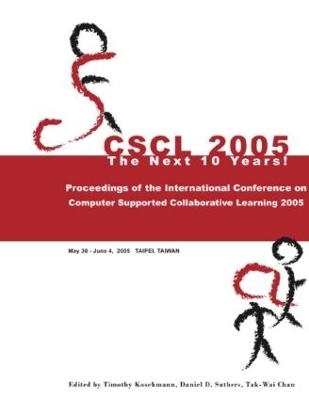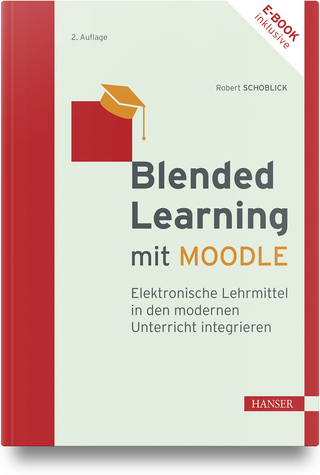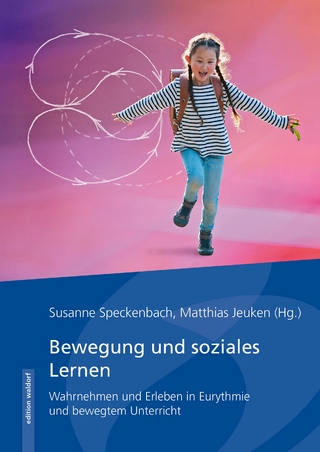
Computer Supported Collaborative Learning 2005
Routledge (Verlag)
978-0-8058-5782-5 (ISBN)
The Computer Supported Collaborative Learning (CSCL) conference has become an internationally-recognized forum for the exchange of research findings related to learning in the context of collaborative activity and the exploration of how such learning might be augmented through technology. This text is the proceedings from CSCL 2005 held in Taipei, Taiwan. This conference marked the 10th anniversary of the first CSCL Conference held at Indiana University in 1995. Subsequent meetings have been held at the University of Toronto, Stanford University, University of Maastricht (Netherlands), University of Colorado at Boulder, and the University of Bergen (Norway).Just as the first CSCL conference was instrumental in shaping the trajectory of the field in its first decade, the conference in Taipei will play an important role in consolidating an increasingly international and interdisciplinary community and defining the direction of the field for the next 10 years. This volume, and the papers from which it is comprised, will be an important resource for those active in this area of research and for others interested in fostering learning in settings of collaboration.
Koschmann, Timothy
Steering Committee, Program Committee, Additional Reviewers, Sponsors, Preface, (BPN) =Best Paper Nomination; (BSPN) = Best Student Paper Nomination, 1 Action Context and Target Context Representations: A Case Study on Collaborative Design Learning, 2 (BPN) Coercing Knowledge Construction in Collaborative Learning Environments, 3 Improving the Coordination of Collaborative Learning with Process Models, 4 AGQ: A Model of Student Question Generation Supported by One-on-One Educational Computing, 5 Effective Discussions, Social Talks and Learning: A Paradox on Learning in Discussion Forums, 6 Animal Companions as Motivators for Teammates Helping Each Other Learn, 7 MatrixDesks: Interactive Computing Desks toward One-on-Two Educational Computing Environments, 8 (BSPN) Problem-Based Learning Online: Multiple Perspectives on Collaborative Knowledge Construction, 9 A Pilot Study of Computer Supported Learning by Constructing Instruction Notes and Peer Expository Instruction, 10 Measuring Motivation in Collaborative Inquiry-Based Learning Contexts, 11 (BPN) Analyzing the Quality of Argumentation Supported by Personally-Seeded Discussions, 12 Why Member Portraits Can Undermine Participation, 13 ICT Can Recover Collaborative Tutorial Conversation and Position It within Undergraduate Curricula, 14 Researching Collaborative Knowledge Building in Formal Distance Learning Environments, 15 (BPN) Making a Mesh of It: A STELLAR Approach to Teacher Professional Development, 16 Designing Collaborative Learning Systems: Current Trends & Future Research Agenda, 17 (BPN) Supporting CSCL with Automatic Corpus Analysis Technology, 18 (BPN) A Study of the Foundations of Artifact-Mediated Collaboration, 19 Effects of an Individual's Prior Knowledge on Collaborative Knowledge Construction and Individual Learning Outcomes in Videoconferencing, 20 The SENSE Project: A Context-Inclusive Approach to Studying Environmental Science within and Across Schools, 21 (BSPN) No Need to Read Messages Right Now: Helping Mediators to Steer Educational Forums Using Statistical and Visual Information, 22 (BPN) The Role of Floor Control and of Ontology in Argumentative Activities with Discussion-Based Tools, 23 ACT: A Web-Based Adaptive Communication Tool, 24 The Effects of Electronic Communication Support on Presence Learning Scenarios, 25 From Parallel Play to Meshed Interaction: The Evolution of the eSTEP System, 26 The Shape of the Elephant: Scope and Membership of the CSCL Community, 27 Building Bridges within Learning Communities through Ontologies and Thematic Objects, 28 A New Role for Computer-Mediated Communication in Engaging Teacher Learning within Informal Professional Communities, 29 Preserving Authenticity in CoLs and CoPs: Proposing an Agenda for CSCL, 30 V -Share - Video-Based Analysis and Reflection of Teaching Experiences in (Virtual) Groups, 31 CSCL- The Next Ten Years- A View from Europe, 32 Design Principles for Online Peer-Evaluation: Fostering Objectivity, 33 Problem Solving as a Complex, Evolutionary Activity: A Methodological Framework for Analyzing Problem-Solving Processes in a Computer-Supported Collaborative Environment, 34 Our Way to Taipei- An Analysis of the First Ten Years of the CSCL Community, 35 (BSPN) Anonymity Options and Professional Participation in an Online Community of Practice, 36 The Evolution of the Intellectual Partnership with a Cognitive Tool in Inquiry-Based Astronomy Laboratory, 37 Review of Computer-Mediated Collaborative Concept Mapping: Implication for Future Research, 38 Weak Guidance with Look Functionality in Handheld-Based Classroom Activities, 39 (BSPN) The Effects of Remote Gesturing on Distance Instruction, 40 Collaborative Learning through Augmented Reality Role Playing, 41 Mystery at the Museum -A Collaborative Game for Museum Education, 42 Progressive Refinement of a CSCL-Based Lesson Plan for Improving Student Learning as Knowledge Building in the Period for the Integrated Study, 43 (BPN) (BSPN) Internal and External Collaboration Scripts in Web-Based Science Learning at Schools, 44 A Cognitive Tool in Handheld Devices for Collaborative Learning: Comprehending Procedural Knowledge of the Addition of Common Fractions, 45 Arguing on the Computer, 46 A Lightweight Approach for Flexible Group Management in the Classroom, 47 Information and Communications Technology and Literacy Development, 48 Language Learning in a Virtual Classroom: Synchronous Methods, Cultural Exchanges, 49 Assessing Learning Outcomes in CSCL Settings, 50 (BPN) Students Assessing Their Own Knowledge Advances in a Knowledge Building Environment, 51 (BSPN) Vulgar Competence, Ethnomethodological Indifference and Curricular Design, 52 How Representation Matters: Comparing Collaborative Learning with Alternative Versions of Hypermedia, 53 A Structured Chat Framework for Distributed Educational Settings, 54 (BSPN) We Learn Better Together: Enhancing eLearning with Emotional Characters, 55 Cognitive Tutoring of Collaboration: Developmental and Empirical Steps Towards Realization, 56 CSCL Scripts: Modelling Features and Potential Use, 57 An Experimental Study on Collaborative Scientific Activities with an Actual/Imaginary Partner, 58 (BPN) Promotion of Self-Assessment for Learners in Online Discussion Using the Visualization Software, 59 Designing for Constructionist Web-Based Knowledge Building, 60 Explicit Referencing in Chat Supports Collaborative Learning, 61 iTree: Does the Mobile Phone Encourage Learners to be More Involved in Collaborative Learning?, 62 From CSCL Classroom to Real-World Settings through Project-Based Learning, 63 Collaborative Scaffolding in Synchronous Environment: Congruity and Antagonism of Tutor/Student Facilitation Acts, 64 Assessment of Collaboration in Online Courses, 65 (BSPN) Mediated Chat Development Process: Avoiding Chat Confusion on Educational Debates, 66 Computer-Supported Collaboration in a Scripted 3-D Game Environment, 67 Mining Learning Groups' Activities in Forum:type Tools, 68 Establishing Communities of Practice among Students and Start-Up Companies, 69 Towards A Design Framework for Mobile Computer-Supported Collaborative Learning, 70 Implementing Online Collaborative Professional Development for Innovative Educators, 71 Local and Distributed Interaction in a Collaborative Knowledge Building Scenario, 72 Supporting Collaborative Discovery Learning by Presenting a Tool, 73 (BSPN) Experiences with Interactive Lectures - Considerations from the Perspective of Educational Psychology and Computer Science, 74 The Impact of Role Assignment as Scripting Tool on Knowledge Construction in Asynchronous Discussion Groups, 75 A New Direction for Log File Analysis in CSCL: Experiences with a Spatio-temporal Metric, 76 (BPN) Teaching Distributed Software Development with the Project Method, 77 Non-linear Dynamical Development of CSCL Communities, 78 Why all CSL is CL: Distributed Mind and the Future of Computer Supported Collaborative Learning, 79 Fostering Social Presence in Asynchronous Online Class Discussions, 80 (BSPN) Instructional Methods for CSCL: Review of Case Studies, 81 Understanding Computer Mediated Social Experience: Implications for CSCL, 82 A New Method to Assess the Quality of Collaborative Process in CSCL, 83 Group Cognition: The Collaborative Locus of Agency in CSCL, 84 How Can We Use Hypervideo Design Projects to Construct Knowledge in University Courses?, 85 (BPN) Functional versus Spontaneous Roles during CSCL, 86 Identifying Peer Interaction Patterns and Related Variables in Community-Based Learning, 87 (BPN) Technology Affordances for Intersubjective Learning: A Thematic Agenda for CSCL, 88 Using Paper to Support Collaboration in Educational Activities, 89 A Heterogeneous Animated Platform for Educational Participatory Simulations, 90 (BSPN) The Effect of Video-Augmented Chat on Collaborative Learning with Cases, 91 CSC*: Computer Supported Collaborative Work, Learning, and Play, 92 Exploring Collaborative Aspects of Knowledge Building Through Collaborative Summary Notes, 93 (BPN) Towards a Dialogic Understanding ofthe Relationship between CSCL and Teaching Thinking Skills, 94 Computer-Supported Collaborative Learning in Higher Education: Scripts for Argumentative Knowledge Construction in Distributed Groups, 95 Macroscopic Study of the Social Networks Formed in Web-based Discussion Forums, 96 Story-Lines: A Case Study of Online Learning Using Narrative Analysis, 97 Advanced Digital Video Technologies to Support Collaborative Learning in School Education and Beyond, 98 (BPN) Usability as an Interactional Resource: Deictic Management of Scene Formulation, 99 Texts-In-Interaction: Collaborative Problem-Solving in Quasi-Synchronous Computer-Mediated Communication, 100 Analyzing and Supporting Collaboration in Cooperative Computer-Mediated Communication, Subject Index, Author Index
| Erscheint lt. Verlag | 11.11.2005 |
|---|---|
| Verlagsort | New York |
| Sprache | englisch |
| Maße | 219 x 276 mm |
| Gewicht | 1746 g |
| Themenwelt | Schulbuch / Wörterbuch ► Unterrichtsvorbereitung ► Unterrichts-Handreichungen |
| Sozialwissenschaften ► Pädagogik | |
| ISBN-10 | 0-8058-5782-6 / 0805857826 |
| ISBN-13 | 978-0-8058-5782-5 / 9780805857825 |
| Zustand | Neuware |
| Informationen gemäß Produktsicherheitsverordnung (GPSR) | |
| Haben Sie eine Frage zum Produkt? |
aus dem Bereich


